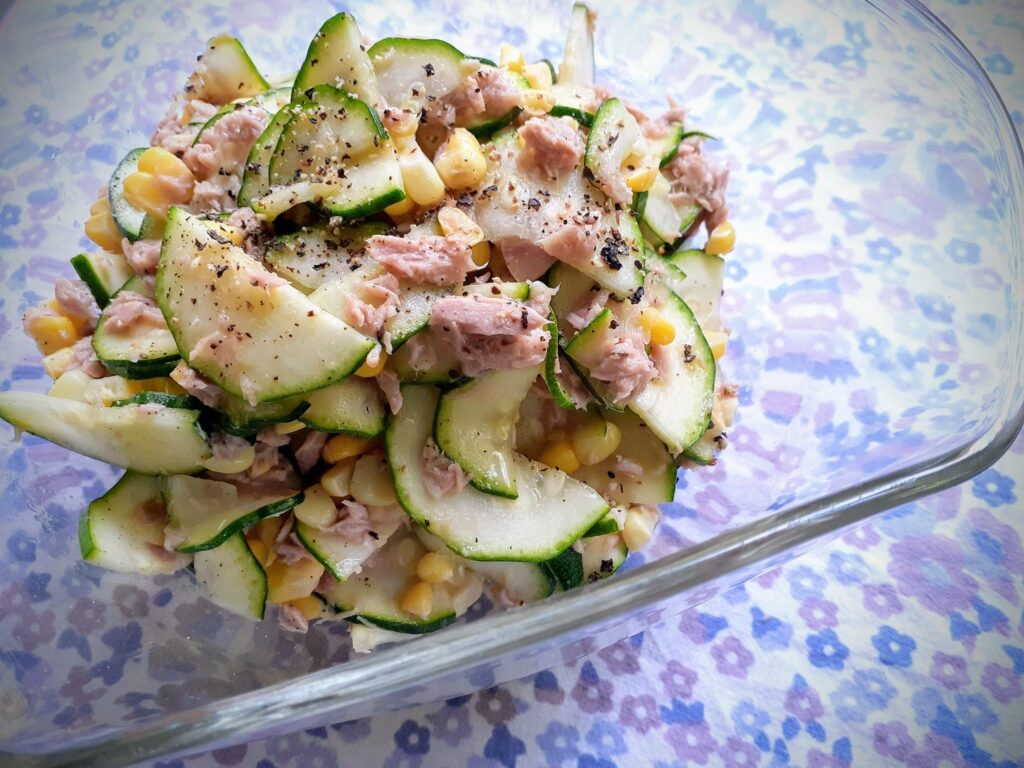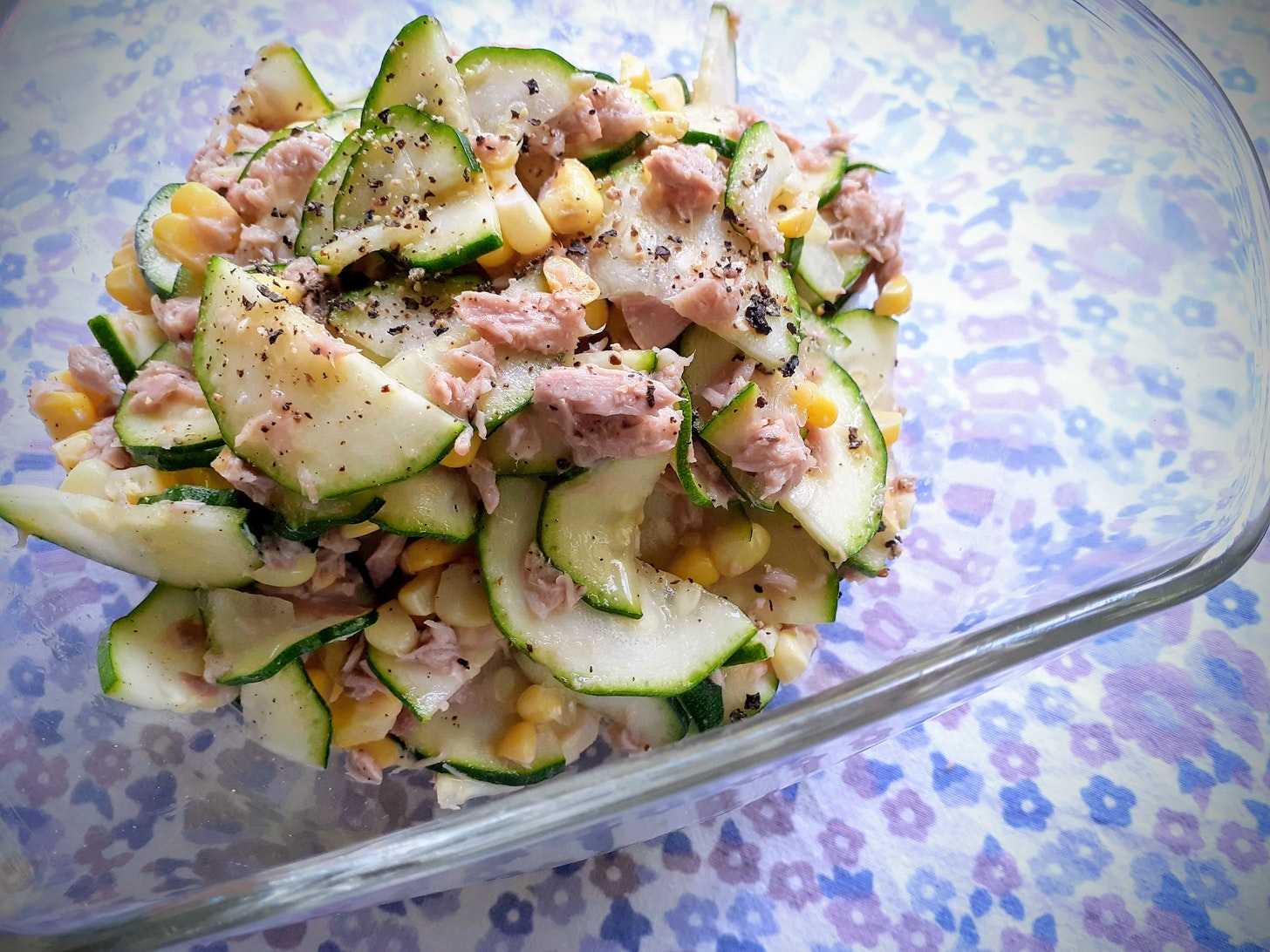We grow courgettes in our vegetable garden and we are able to harvest plenty every day. This time I used fresh courgette to make a salad. So today, we are going to read the recipe in Japanese.
The Japanese recipes often have many technical words, some of which are not commonly heard in everyday conversations. Here, I have chosen a recipe that includes as few technical words as possible.

Japanese text
材料
- ズッキーニ:1本
- とうもろこし:1本
- ツナ缶:1缶
- 塩:少々
- 黒こしょう:少々
作り方
- とうもろこしは茹でるか蒸したあと、カットして粒状にしておく。
- ズッキーニは半分に切ってから薄切りにし、塩をもみ込む。
- ツナ缶は水気(あるいはオイル)をとりのぞく。
- ズッキーニから水分が出てきたら軽く絞り、その他の材料をすべて加えて出来上がり。
Japanese text in Hiragana and Pronunciations
ざいりょう
Zairyoo
ズッキーニ(ずっきーに):いっぽん
Zukkini: ippon
とうもろこし:いっぽん
Toomorokoshi: ippon
ツナ(つな)かん:いっかん
Tsuna kan: ikkan
しお:しょうしょう
Shio: shooshoo
くろこしょう:しょうしょう
Kurokoshoo: shooshoo
つくりかた
Tsukurikata
とうもろこしはゆでるかむしたあと、カット(かっと)してつぶじょうにしておく。
Toomorokoshi wa yuderu ka mushita ato, katto shite tsubu joo ni shiteoku
ズッキーニ(ずっきーに)ははんぶんにきってからうすぎりにし、しおをもみこむ。
Zukkiini wa hanbun ni kitte kara usugiri ni shi, shio wo momikomu
ツナ(つな)かんはみずけ(あるいはオイル(おいる))をとりのぞく。
Tsuna kan wa mizuke (aruiwa oiru) wo torinozoku
ズッキーニ(ずっきーに)からすいぶんがでてきたらかるくしぼり、そのたのざいりょうをすべてくわえてできあがり。
Zukkiini kara suibun ga dete kitara karuku shibori, sonota no zairyoo wo subete kuwaete dekiagari.
English Translation
Ingredients
- courgette: 1
- corn: 1 corn on the cob
- canned tuna: 1
- salt: a pinch
- black pepper: a pinch
Preparation
- Boil or steam the corn and take the corn off the cob.
- Cut the courgette in half and then into thin slices, season with salt.
- Drain the water (or oil) from the canned tuna.
- Squeeze the water out of the courgette and add all the other ingredients.
>Read the full episode in English on my blog
Pick up for beginners!
Counting long and skinny things: 本
In Japanese, when we count long, thin things, we use the form “number + 本”.
Confusingly, “本” is a Kanji character that means “books”, but we don’t use it when we count books.
We use “本” when we count something long and thin such as pens, sticks, umbrellas, trees, bottles, but also gutters, emails, phone calls, films, etc.
For beginners, please note that the pronunciation of “本 (hon)” changes depending on the number before it.
- 1 : 一本 いっぽん ippon
- 2 : 二本 にほん nihon
- 3 : 三本 さんぼん sanbon
- 4 : 四本 よんほん yonhon
- 5 : 五本 ごほん gohon
- 6 : 六本 ろっぽん roppon
- 7 : 七本 ななほん (しちほん) nanahon (shichihon)
- 8 : 八本 はちほん (はっぽん) hatihon (happon)
- 9 : 九本 きゅうほん kyuuhon
- 10 : 十本 じゅっぽん (じっぽん) juppon (jippon)
- 11 : 十一本 じゅういっぽん juuippon
- 12 : 十二本 じゅうにほん juunihon
- 100 : 百本 ひゃっぽん/ひゃくほん hyappon (hyakuhon)
- 1,000 : 千本 せんぼん senbon
- 10,000 : 一万本 いちまんぼん ichimanbon
- how many : 何本 なんぼん (なんほん) nanbon (nanhon)
Vocabulary
- 材料 zairyoo: ingredients
- ズッキーニ zukkiini: courgette (zucchini)
- とうもろこし toomorokoshi: corn
- ツナ缶 tsuna kan: canned tuna
- 1缶 ikkan: 1 can
- 塩 shio: salt
- 少々shooshoo: a little
- 黒こしょう kurokoshoo: black pepper
- 作り方 tsukurikata: how to make
- 茹でる yuderu: to boil (ru verb / ichidan verb)
- 蒸した mushita: steamed (plain form, past tense of u verb / godan verb 蒸す)
- あと ato: after
- カットしてkatto shite: cut (te form of suru verb カットする)
- 粒状 tsubujoo: granular
- 半分 hanbun: half
- 切って kitte: cut (te form of u verb / godan verb 切る
- 薄切り usugiri: thin-slice
- もみ込む momikomu: to rub (u verb / godan verb)
- 水気 mizuke: moisture
- あるいは aruiwa: or
- オイル oiru: oil
- とりのぞく torinozoku: remove (u verb / godan verb)
- 水分 suibun: moisture, liquid
- 出てきた detekita: came out (plain form, past tense of kuru verb 出てくる)
- 軽くkaruku: roughly
- 絞り shibori: to squeeze (masu form of u verb / godan verb 絞る)
- その他 sonota: others
- すべて subete: all
- 加えて kuwaete: add (te form of ru verb / ichidan verb 加える)
- 出来上がり dekiagari: finished, it’s done



Comments